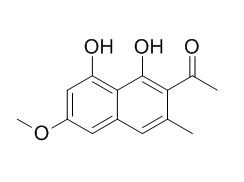Torachrysone
Torachrysone shows promising antioxidant activity. Torachrysone, toralactone , aloe-emodin, rhein and emodin show noticeable antibacterial effects on four strains of methicillin-resistant Staphylococcus aureus with a minimum inhibitory concentration of 2-64 micrograms/ml.
Inquire / Order:
manager@chemfaces.com
Technical Inquiries:
service@chemfaces.com
Tel:
+86-27-84237783
Fax:
+86-27-84254680
Address:
1 Building, No. 83, CheCheng Rd., Wuhan Economic and Technological Development Zone, Wuhan, Hubei 430056, PRC
Providing storage is as stated on the product vial and the vial is kept tightly sealed, the product can be stored for up to
24 months(2-8C).
Wherever possible, you should prepare and use solutions on the same day. However, if you need to make up stock solutions in advance, we recommend that you store the solution as aliquots in tightly sealed vials at -20C. Generally, these will be useable for up to two weeks. Before use, and prior to opening the vial we recommend that you allow your product to equilibrate to room temperature for at least 1 hour.
Need more advice on solubility, usage and handling? Please email to: service@chemfaces.com
The packaging of the product may have turned upside down during transportation, resulting in the natural compounds adhering to the neck or cap of the vial. take the vial out of its packaging and gently shake to let the compounds fall to the bottom of the vial. for liquid products, centrifuge at 200-500 RPM to gather the liquid at the bottom of the vial. try to avoid loss or contamination during handling.
Plants (Basel).2020, 9(11):1422.
J Ethnopharmacol.2017, 206:327-336
US20170000760 A12016, 42740
Biomolecules.2023, 13(2):227.
Metabolites.2023, 13(5):625.
Saudi Pharm J2020, 10.1016
Int J Biol Macromol.2025, 292:139225.
Plant Pathology2022, 10.1111:ppa.13651.
Advances in Traditional Medicine2020, 10.1007
Auburn University2015, 1-58
Related and Featured Products
Chem. Pharm. Bull.(Tokyo).,1999, 47(8): 1121-7.
Phenolic constituents of Cassia seeds and antibacterial effect of some naphthalenes and anthraquinones on methicillin-resistant Staphylococcus aureus.[Pubmed:
10478467]
Thirteen phenolic glycosides including six new compounds were isolated from seeds of Cassia tora (Leguminosae).
METHODS AND RESULTS:
The structures of the new compounds, rubrofusarin triglucoside (7), nor-rubrofusarin gentiobioside (9), demethylflavasperone gentiobioside (10), Torachrysone gentiobioside (11), Torachrysone tetraglucoside (12) and Torachrysone apioglucoside (13), were elucidated on the basis of spectroscopic and chemical evidence. The effects of the phenolic glycosides, their aglycones and several other compounds structurally related to them on Escherichia coli K12, Pseudomonas aeruginosa PAO1 and some strains of Staphylococcus aureus were then examined.
CONCLUSIONS:
Among them, Torachrysone (15), toralactone (16), aloe-emodin (18), rhein (19) and emodin (20) showed noticeable antibacterial effects on four strains of methicillin-resistant Staphylococcus aureus with a minimum inhibitory concentration of 2-64 micrograms/ml. On the other hand, the phenolic compounds tested did not show strong antibacterial effects on E. coli and P. aeruginosa.
Molecules. 2014 Aug 4;19(8):11453-64.
An unusual piceatannol dimer from Rheum austral D. Don with antioxidant activity.[Pubmed:
25093985]
METHODS AND RESULTS:
A novel dimer of piceatannol glycoside, named rheumaustralin (1) was isolated from the underground parts of the ethnomedicinal plant Rheum austral (Polygonaceae) collected from Tibet together with 17 known compounds, including rheumin (2), 2,5-dimethyl-7-hydroxychromone (3), 2,5-dimethylchromone-7-O-β-D-glucopyranoside (4), 7-hydroxy-2-(2'-hydroxypropyl)-5-methylchromone (5), Torachrysone (6) Torachrysone-8-O-β-D-glucopyranoside (7), 4-(4'-hydroxyphenyl)-2-butanone-4'-O-β-D-glucopyranoside (8), amabiloside (9), N-trans-feruloyl tyramine (10), chrysophanol (11), aloe-emodin (12), emodin (13), physcion (14), physcion-1-O-β-D-glucopyranoside (15), emodin-8-O-β-D-glucopyranoside (16), D-catechin (17) and gallic acid (18).
CONCLUSIONS:
Their structures were determined by combined spectroscopic methods and by comparison of their spectral data with those reported in literature. Compounds 1-10 were tested for their ability to scavenge 1, 1-diphenyl-2-picrylhydrazyl (DPPH) radical.



